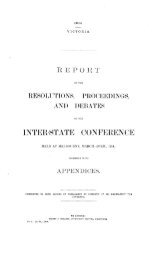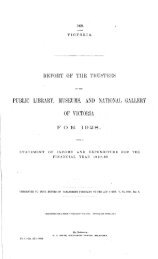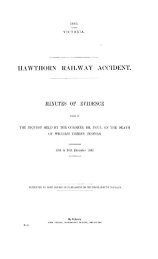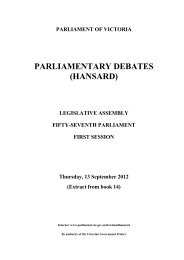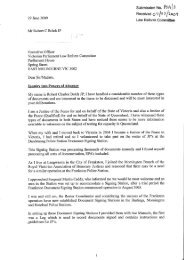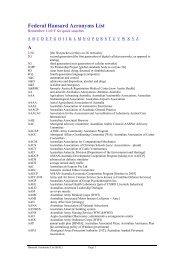Book 8 - Parliament of Victoria
Book 8 - Parliament of Victoria
Book 8 - Parliament of Victoria
You also want an ePaper? Increase the reach of your titles
YUMPU automatically turns print PDFs into web optimized ePapers that Google loves.
AUSTRALIAN SYNCHROTRON: FUNDING<br />
Wednesday, 1 June 2011 COUNCIL 1639<br />
community. The Australian Synchrotron is the<br />
country’s largest user facility and the only operation <strong>of</strong><br />
its kind in Australia. It is a major part <strong>of</strong> <strong>Victoria</strong>’s, and<br />
the nation’s, scientific infrastructure, providing<br />
significant capabilities and delivering scientific,<br />
educational and industrial benefits to <strong>Victoria</strong>, to the<br />
rest <strong>of</strong> Australia and to New Zealand. I might add that<br />
the industrial benefits are not well known, but they are<br />
significant, and I will talk a little more about them later<br />
in my contribution.<br />
Many <strong>of</strong> the highest impact research programs which<br />
depend on the synchrotron are very difficult to conduct<br />
overseas. For example, it is <strong>of</strong>ten impossible, for<br />
obvious reasons, to send biological tissue, live animals<br />
and soil and plant samples <strong>of</strong>fshore. The number <strong>of</strong><br />
users <strong>of</strong> the synchrotron has increased exponentially<br />
since 2008 when 325 people used the facility. In<br />
February 2010, 1600 people used the synchrotron.<br />
At this point I want to touch on some <strong>of</strong> the<br />
achievements <strong>of</strong> the Australian Synchrotron in the hope<br />
that government members might be galvanised into<br />
lobbying ministers and the Premier to save this facility.<br />
The achievements <strong>of</strong> the synchrotron include<br />
successfully staging the peak international synchrotron<br />
science and technology conference, which is held every<br />
three years and is hosted by a major international<br />
synchrotron user facility. I am informed that hosting<br />
such an event is very prestigious for the host country<br />
and host synchrotron.<br />
The synchrotron hosts over 3000 domestic and<br />
international research visits per year. It has also been<br />
instrumental in the lodging <strong>of</strong> 15 new patents. It has<br />
generated 336 scientific papers since 2007, which is a<br />
great deal, and these have been in areas as diverse as<br />
immunology, biomedicine, mineral processing,<br />
environmental sustainability, food security, accelerator<br />
physics and instrument development. This is equal to or<br />
better than any other leading synchrotron at a<br />
comparable time <strong>of</strong> its development. A further<br />
420 papers were generated by work done at the<br />
Australian National Beamline Facility. Of these<br />
756 scientific papers, approximately 70 per cent have<br />
appeared in journals with an A-star or A rating under<br />
the Excellence in Research for Australia assessment<br />
scheme, including leading international science journals<br />
such as Nature. This is comparable to the performance<br />
<strong>of</strong> Australia’s best research groups.<br />
Research undertaken at the facility is making a positive<br />
contribution to Australia’s national research priorities,<br />
creating an environmentally sustainable Australia,<br />
promoting and maintaining good health, developing<br />
frontier technologies for building and transforming<br />
Australian industries, and safeguarding Australia. The<br />
Australian Synchrotron has attracted new research<br />
infrastructure grants totalling $51.48 million, which are<br />
being used to further strengthen the facility’s<br />
capabilities. The fact that the synchrotron has attracted<br />
that funding indicates that it is ticking all the right<br />
boxes in terms <strong>of</strong> where it is going as a major piece <strong>of</strong><br />
scientific infrastructure.<br />
Activities undertaken by commercial clients — and this<br />
is the area <strong>of</strong> most relevance to this motion — are<br />
contributing to the development <strong>of</strong> anti-infective drugs,<br />
electronic and bio-analytical measurement instruments,<br />
bi<strong>of</strong>uel products, pharmaceutical and nutraceutical<br />
products and bio-pharmaceuticals.<br />
The Australian Synchrotron’s beamlines are<br />
oversubscribed. In some cases requests for beam time<br />
are more than three times the availability,<br />
demonstrating the high demand for its techniques.<br />
Between 2007 and 2008 cumulative publication<br />
numbers for two <strong>of</strong> the synchrotron’s most popular<br />
techniques, powder diffraction and macromolecular<br />
crystallography, rose from zero to 50 and 100<br />
respectively. There is more I can say, but in the<br />
interests <strong>of</strong> time I will end my elaboration <strong>of</strong> the<br />
achievements there and continue with my contribution.<br />
The achievements <strong>of</strong> the synchrotron demonstrate how<br />
much <strong>Victoria</strong> and Australia need the synchrotron. The<br />
synchrotron gives us a leading and competitive edge in<br />
technology, research and development. We are<br />
currently at the forefront <strong>of</strong> major scientific discoveries.<br />
We have opportunities that are available to only a small<br />
number <strong>of</strong> countries. There are fewer than 40 such<br />
facilities in the world. It is the largest stand-alone<br />
scientific structure in the Southern Hemisphere, yet it is<br />
at risk.<br />
Earlier in my contribution I asked how we came to a<br />
position whereby scientific infrastructure critical for the<br />
future <strong>of</strong> our state is now being put at risk. How did we<br />
come to this? We came to this by the coalition playing<br />
irresponsible, inane, lowest-common-denominator<br />
retail politics — in other words, it made some<br />
outrageous promises and never thought it would be in a<br />
position to implement those promises. In order to<br />
implement at least some <strong>of</strong> its promises, the Baillieu<br />
government had to cry poor, hence the black holes.<br />
Having cried poor and supposedly s<strong>of</strong>tened up the<br />
electorate, it then had to find cuts that could be made,<br />
and the most logical way to cut programs was to find<br />
programs which had lapsed. That is how it landed on<br />
the synchrotron.



